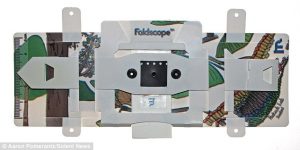Our class was lucky to have two guest speakers this week—Alan Amling from UPS spoke about how the company is leveraging 3D printing technology in new ways in order to grow its business and cater to the growing demand from its clients, and Dot Silverman spoke about biohacking, and its various applications from education, to industry.
It was really interesting to learn about how UPS has integrated additive manufacturing into its offerings to clients, and has consistently been able to stay ahead of the curve. Their services now enable anyone from a large manufacturer to a solo entrepreneur to order prints and access technology that they might not be able to invest in themselves.
In addition to speaking about how the technology has impacted UPS, Alan shared insights about other companies that now rely on digital making to customize for or deliver additional value to their customers. One example I thought was quite interesting was that of Nike, which is using 3D printing to create customized shoe soles based off of a scan of one’s foot. After doing additional research, I learned that several other footwear companies are using the same approach. This Fortune article talks about how New Balance, Adidas, and Nike are all investing in on-demand manufacturing processes for the long term.
I also really enjoyed hearing from Dot, because I thought her background was quite unique. She studied physics during her undergraduate years and has worked at several research labs, but is currently pursuing a graduate degree in education. Many of the projects she highlighted within the biohacking realm had to do with making science education more accessible for all, and it was really inspiring because she seemed to perfectly exemplify someone with a maker mindset. I was particularly impressed by the Foldscope, which is essentially a microscope that can provide up to 2000x magnification, and costs less than $1 to make. It was invented by two Stanford graduate students, and has now fostered a global learning community across 135 countries. I found the Microcosmos page of their website to be quite touching– it features stories from various users who have documented their learning processes while using the Foldscope.

In summary, I’d say that this week’s learnings offered a lot of practical insight as to how the maker community is so deeply rooted in making learning via technology far more accessible. While one might expect this from academia/educators, the same holds true for large corporations like UPS, who are actually able to drive profitability by adhering to the same principle.

Hey Ria! I like how you pointed out Dot’s career path. I was the one in class who asked her to expand upon her background – I find unconventional paths are usually taken by bright, creative, and curious people. Dot was no exception! Her interest in education and biology stemmed from pure curiosity – they had nothing to do with her undergraduate physics major! That’s why I am so inspired by her. When I get tired of the business work I’ll be doing once I graduate, I hope to be able to pursue my interests outside of business.
Hi Ria,
Thank you for sharing the article pertaining to 3D printed shoes. Reading about customizations like these gets me thinking about how many more items could be specifically customized for each individual consumer. For instance, there could be custom-fit shirts, pants, watches, hats, pens, etc. There is an unlimited amount of possibilities to further cater to customer needs through 3D printing.
-Scott Provenzano
Ria,
Thanks for your post! I also really enjoyed hearing about Dot’s unique background. I had no idea about the Foldscope background – I love the entrepreneurial development process but philanthropic and educational application behind it! It’s really not something you see anymore.
Thanks for sharing the Microcosmos page! It’s truly inspiring to read about how this simple ‘hack’ is opening the eyes of people everywhere to the “micro” world!
Best,
Ajie